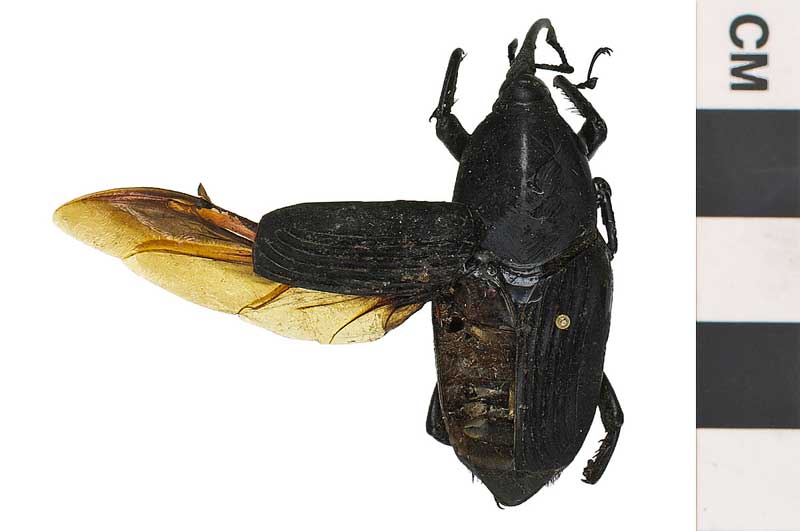
Superregnum: Eukaryota
Cladus: Unikonta
Cladus: Opisthokonta
Cladus: Holozoa
Regnum: Animalia
Subregnum: Eumetazoa
Cladus: Bilateria
Cladus: Nephrozoa
Cladus: Protostomia
Cladus: Ecdysozoa
Cladus: Panarthropoda
Phylum: Arthropoda
Subphylum: Hexapoda
Classis: Insecta
Cladus: Dicondylia
Subclassis: Pterygota
Cladus: Metapterygota
Infraclassis: Neoptera
Cladus: Eumetabola
Cladus: Endopterygota
Superordo: Coleopterida
Ordo: Coleoptera
Subordo: Polyphaga
Superfamilia: Curculionoidea
Familia: Curculionidae
Subfamilia: Dryophthorinae
Tribus: Rhynchophorini
Genus: Rhynchophorus
Species: Rhynchophorus cruentatus (J.C.Fabricius, 1775)
The palmetto weevil (Rhynchophorus cruentatus) is an insect native to Florida, but has been found as far as southern Texas to the west and South Carolina to the north.[1][2] It is the largest weevil in North America and the only kind of palm weevil in the continental United States.[1] It infests palms and is considered a pest.[1][3][4] Its main target is the Canary Island date palm, but date palms (a different species than the Canary Island date palm), sabal palms (the palmetto weevil's traditional target), saw palmetto (the palmetto weevil's traditional alternative target), Washingtonia, Pritchardia, royal palms, Latania, coconut palms, Caryota, and Bismarckia are also susceptible.[1][2][3][5] Distressed palm trees are usually attacked, which makes transplanted trees a frequent target.[3] The Palmetto Weevils mate at the base of the palm branches where the females deposit their eggs.[3] The grubs then eat into the palm tree, killing it.[3] After the larvae have turned into adult weevils, the damage can be seen, but by then, it is considered to be too late for the tree.[1][3] The life cycle from egg to adult for a palmetto weevil is about 84 days.[6] For prevention, it is recommended an appropriate insecticidal crown drench is done twice a year for high value palms.[3]
Grubs of other species of palm weevils are considered a delicacy in countries outside the United States.[1]
Palmetto weevil are most active in late spring and early summer.[1]
References
"palmetto weevil - Rhynchophorus cruentatus Fabricius".
"Palm Insects & Diseases".
"Palm insect pests common to north and central Florida". Archived from the original on 2010-05-26. Retrieved 2010-07-19.
Jones, David L. (1995). Palms throughout the World. Washington, D.C: Smithsonian Institution Press. p. 82. ISBN 1-56098-616-6.
Palmetto weevil 1. 8 December 2009. Archived from the original on 2021-12-15 – via YouTube.
Weissling TJ, Giblin-Davis RM. (1994). Fecundity and fertility of Rhynchophorus cruentatus (Coleoptera: Curculionidae). Florida Entomologist 77
Retrieved from "http://en.wikipedia.org/"
All text is available under the terms of the GNU Free Documentation License

